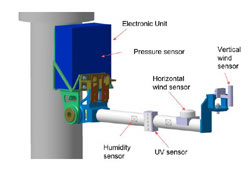|
|
.gif) |
| Science Instruments: REMS |
 |
.gif) |
 |
| Rover Environmental Monitoring
Station |
The Rover Environmental
Monitoring Station would monitor atmospheric pressure,
humidity, wind currents, and ultraviolet radiation from
the sun.
Image credit: NASA/JPL-Caltech/INTA
(Instituto Nacional de Tecnica Aeroespacial) |
| Larger Image
| |
.gif) | Rover Environmental Monitoring Station
(REMS)
The Mars Science Laboratory rover would carry a weather
monitoring station provided by the government of Spain on behalf of
investigators at the Centro de Astrobiología (INTA-CSIC). The Rover
Environmental Monitoring Station would provide a daily report of
atmospheric weather conditions on Mars. Attached to the vertical
mast on the Mars Science Laboratory deck, the station would measure
atmospheric pressure, humidity, ultraviolet radiation from the sun,
wind speed, wind direction, ground temperature, and air
temperature.
A sensor in the electronics box would measure atmospheric
pressure. Separate sensors would track humidity and ultraviolet
radiation. Two wind sensors would detect and characterize
atmospheric circulation. An XY wind sensor would measure wind
direction moving horizontally, similar to breezes blowing across the
surface on Earth, and a Z wind sensor would measure vertical
atmospheric movement, such as thermal currents moving up or
down. |